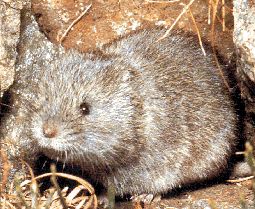
The Arvicolinae are a subfamily of rodents that includes the voles, lemmings, and muskrats. They are most closely related to the other subfamilies in the Cricetidae. Some authorities place the subfamily Arvicolinae in the family Muridae along with all other members of the superfamily Muroidea. Some refer to the subfamily as the Microtinae or rank the taxon as a full family, the Arvicolidae.

Microtus is a genus of voles found in North America, Europe and northern Asia. The genus name refers to the small ears of these animals. They are stout rodents with short ears, legs and tails. They eat green vegetation such as grasses and sedges in summer, and grains, seeds, root and bark at other times. The genus is also called "meadow voles".

Cricetulus is a genus of rodent in the family Cricetidae ; it has seven member species that inhabit arid or semi-arid regions in Eurasia.

Water voles are large voles in the genus Arvicola. They are found in both aquatic and dry habitat through Europe and much of northern Asia. A water vole found in Western North America was historically considered a member of this genus, but has been shown to be more closely related to members of the genus Microtus. Head and body lengths are 12–22 cm, tail lengths are 6.5–12.5 cm, and their weights are 70–250 g. The animals may exhibit indeterminate growth. They are thick-furred and have hairy fringes on their feet that improve their swimming ability.

The reed vole is a species of vole. It is found in northern and central Eurasia, including northern China and the Korean Peninsula. This species is somewhat larger and longer-tailed than most other voles.

The Balkan snow vole, also known as Martino's snow vole, is the only living member of the genus Dinaromys. The genus name means "Dinaric mouse", referring to the Dinaric Alps, as the species is endemic to the western Balkans of southeast Europe. Eight subspecies of this vole have been recognized, although in 2022 this number was reduced to two subspecies. The Balkan snow vole is a living fossil, the only living species in the tribe Pliomyini, and might arguably better be placed in Pliomys, a genus established for its fossil relatives even before the Balkan snow vole was scientifically described. It was described by husband and wife mammalogists Vladimir Emmanuilovich Martino and Evgeniya Veniaminovna Martino. Others have argued that Pliomys should be treated as entirely separate from Dinaromys, with Dinaromys and P. lenki estimated to have genetically diverged around 4 million years ago based on ancient DNA sequences. The earliest representatives of Dinaromys like Dinaromys allegranzii date to the Early Pleistocene, with Dinaromys also inhabiting the Italian Peninsula until the end of the Late Pleistocene, when it contracted to its current distribution.

Chionomys is a genus of rodent in the family Cricetidae.
Pratt's vole, also called the Sichuan red-backed vole, is a species of rodent in the family Cricetidae. It is endemic to Mount Emei, Sichuan, China. It was named in 1891 for Antwerp Edgar Pratt.
The Southwest China vole, or Southwest China red-backed vole, is a species of rodent in the family Cricetidae. It is found only in Yunnan and Sichuan, China. It occurs in Cangshan Erhai Nature Reserve.
The Ganzu vole, Eva's red-backed vole, Eva's vole, Gansu vole, or Taozhou vole is a species of rodent in the family Cricetidae. It is found in mountain forests in China. The IUCN has assessed it as being of "least concern".

Père David's vole is a species of rodent in the family Cricetidae. It is found in China, Myanmar, Taiwan, India, Vietnam, and Thailand. This species is a member of the melanogaster group, one of the two main groups of Eothenomys voles. Its dorsal pelage is dark brown, often nearly black, and the ventral pelage is gray, sometimes brown. The tail is shorter than the body. This species is found in pine/rhododendron forests.
The Chaotung vole, also known as the black-eared red-backed vole, is a species of rodent in the family Cricetidae. It is found only in Yunnan, Sichuan, and Guizhou provinces of south-central China.
The Yulungshan vole, Yulong Chinese vole, Yulongxuen Chinese vole, or Yulongxuen red-backed vole is a species of rodent in the family Cricetidae, endemic to Jade Dragon Snow Mountain in the Sichuan–Yunnan border region of China.
The Shansei vole is a species of rodent in the family Cricetidae. It is found only in north-central China where its habitat is forests.
Maximowicz's vole is a species of rodent in the family Cricetidae. It is found in northeastern China, Mongolia, and eastern Russia.
The Clethrionomyini are a tribe of forest voles in the subfamily Arvicolinae. This tribe was formerly known as Myodini, but when genus Myodes was deemed to be a junior synonym, the tribe was renamed. Species in this tribe are:
Neodon is a genus of rodent in the family Cricetidae. Species within Neodon are classified as relics of the Pleistocene epoch because the occlusal patterns resemble the extinct Allophaiomys.

The Kachin red-backed vole is a species of rodent in the family Cricetidae. It is found in Kachin State in northern Burma. Although described as a species by Thomas in 1921, it was subsequently included as a subspecies of either E. melanogaster or E. miletus. Comparisons of a 1941 sampling showed that E. cachinus was indeed a separate species.
The Yunnan red-backed vole is a species of rodent in the family Cricetidae. It is found in Southwest China, specifically Yunnan Province. It is the largest member of the genus Eothenomys, with a higher cranium, a soft, thick and long coat with tawny brown to reddish brown coloring and grey underparts.
The Ward's red-backed vole is a species of rodent in the family Cricetidae. It is found in China, specifically the north-western area of Yunnan Province. It is sometimes considered a subspecies of Eothenomys chinensis, but most zoologists consider it to be a separate species due to the noticeably shorter tail and hind feet.

















